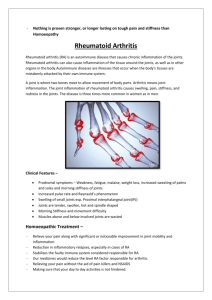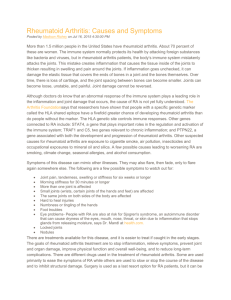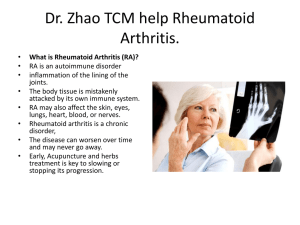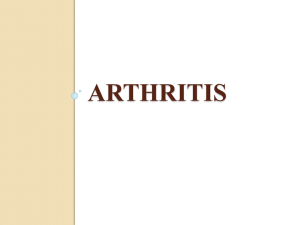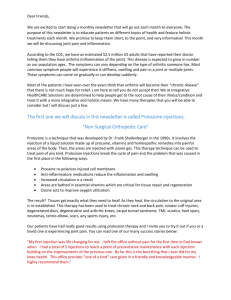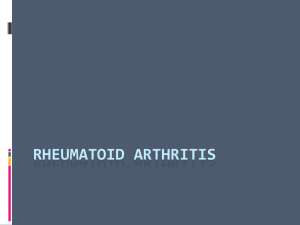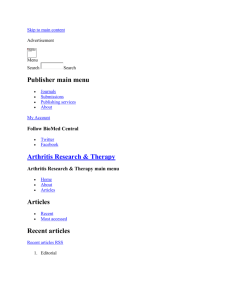Arthritis
advertisement
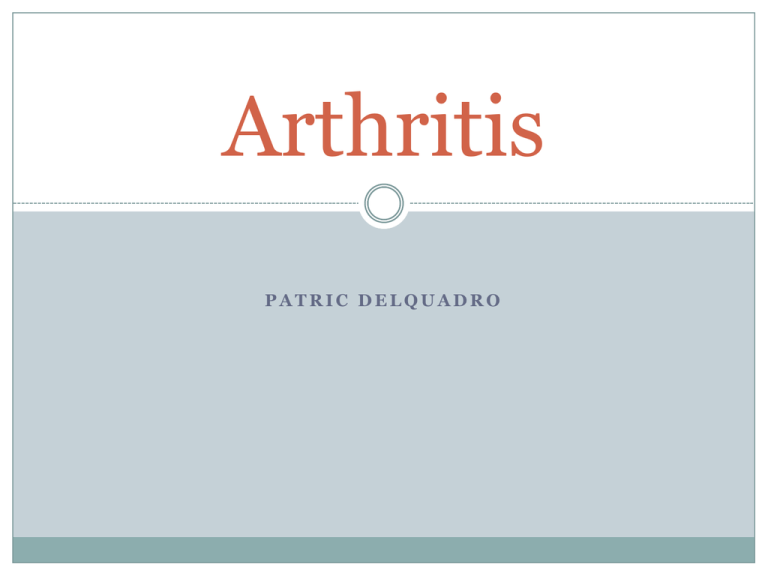
Arthritis PATRIC DELQUADRO Overview Definitions Epidemiology Clinical Aspects Treatment Effects of Exercise Testing Prescription Conclusion References Definitions Osteoarthritis (OA) – Chronic deteriorative disease of cartilage in joints allowing bones to contact/rub causing inflammation. Result of aging, genetics, previous injuries, and overuse. Rheumatoid Arthritis (RA) - Chronic autoimmune disease were the body’s immune system, for reasons unknown, attacks the synovial lining surrounding joints causing inflammation and destruction of joint cartilage. OA Video http://www.youtube.com/watch?v=0dUSmaev5b0 RA Video http://www.youtube.com/watch?v=AYTutNDWPKg Epidemiology Arthritis More than 100 different forms of arthritis 1 in 7 Americans have at least 1 type of arthritis Osteoarthritis 1 in 12 Americans affected Signs start showing after age 45 More common in men >55, women <55 Rheumatoid Arthritis Close to 1% of Americans affected Affects women 3 X to men Symptoms Osteoarthritis (OA) Symptoms include: Stiffness and deep underlying ache or pain in joints Warmth, swelling, and/or redness around joint (inflammation) Reduced ROM Usually felt in early morning, during/post activity, & inactivity Late Stages Bony spurs called Heberden’s nodes develop Audible grinding or crackling noise from joint (crepitation) Joint deformation Spurring or crystallization of bone and/or cartilage Osteoarthritis Images Symptoms Continued Rheumatoid Arthritis (RA) Many of the same symptoms as OA with the exception of: Joint pain is generally equal on both sides of body Prolonged early morning stiffness Greater joint deformation and rheumatoid nodules RA is Systemic Rheumatoid factor affects the whole body Numbness or tingling of the hands and feet Eye burning, chest pain, and/or dry-mouth Damage to cardiorespiratory tissue Fever and fatigue Rheumatoid Arthritis Images Test and Evaluation Physical Exam A traditional physical exam is performed on patients with any type of arthritis Special attention is given to: Joint movement and function Visual appearance noting inflammation, redness, nodes etc. History of symptoms and discomfort Listening for crepitation Blood testing does little to determine if the patient has arthritis. Laboratory Diagnosis Osteoarthritis Joint aspiration Synovial fluid drawn from the joint is examined for deterioration X-ray Less invasive and helpful for observing cartilage and bone health Rheumatoid arthritis Rheumatoid factor (RF) test Blood sample is taken and RF levels are evaluated MRI or Ultrasound Same purpose as x-ray, more detailed and convenient Complications Physically Large joints like knees, shoulders, hips and back/neck are usually most affected by arthritis. This limits physical activity and daily tasks. Joints in hands and feet also become problematic causing issues with balance, gait, and tasks requiring grip strength. Emotionally Physical appearance can be detrimental to the persons confidence and emotion wellbeing. Being limited and in pain can cause a person to give up on exercise leading to a sedentary lifestyle. Treatment The best medicine for any type arthritis is…. STAYING ACTIVE!!! By staying active, joints, bones and muscles are worked encouraging repair and growth. Patients are asked to work through the initial morning pain and discomfort and participate in moderate exercise. Over the counter pain relievers: Acetaminophen (Tylenol) NSAID’s: ibuprofen, aspirin, and naproxen Treatment Continued RA preventative treatments Disease modifying antirheumatic drugs (DMARDs): Rheumatrex, Arava, Gold sodium thiomalate DMARDs target immune processes that cause inflammation and are administered via IV, injection, pill Corticosteroids: Prednisolone These treatments are also used in severe cases of OA Treatment Continued Physical therapy Strengthens muscle and improves ROM Educates patient with usable exercise routines Surgery Arthroscopic surgery Partial and full joint replacements for knees, shoulders, hip, ankle, and elbow. Alignment surgery (knee, elbow, tarsals) Fusion (spine, ankle) Effects of Exercise Capable of improving all system functions Improves joint ROM, stability, and function Decreases inflammation and pain in joints Creates positive social wellbeing and outlook on life Increases activity and productivity Ability to Exercise Special Considerations Joint stability must be planned for and monitored Only low impact exercises should be used Allow ample time for warm-up/cool down, especially early day Progression in exercise intensity should be gradual Progression in duration before intensity Good shock absorbing shoes should be worn during exercise Risk and issues increase with overweight/obese clients Medications and Exercise No exercise specific side-affects with DMARDs Methotrexate Increased bruising, nausea, decrease in energy Arava Increased bruising, chest pain, numbness and weight loss Gold sodium thiomalate Abdominal pain, shortness of breath, and bruising Exercise Testing Methods Strength Repetition Max (1, 8, or 12 reps) Isometric knee extension Standardized functional measures Endurance 6 min walk Cycle Ergometer Flexibility Goniometry Measures Timed chair rise Timed up and go HR Functional ROM Assess Symmetry Exercise Prescription Frequency, Intensity, Time an Type (FITT) FITT principles apply same as a healthy individual Resistance Aerobic Flexibility Frequency 2-3 day/week 3-5 day/week Daily Intensity Start @ 10% Max Increase 10% (Max) weekly 60-80% HR peak Pain Dependent Tension (not pain) Time 10-15 rep warm-up 3-5 exercises 5-10 reps (tolerable) 5-10 min warm-up 20-30 min (tolerable) 5-10 min Beginning of day Pre/Post Exercise Type Circuit training Free/Machine Weights Elastic bands Isometric Low resistance Walking Cycling Water aerobics ROM joint stretching All major muscles Importance of Flexibility at 80 http://www.youtube.com/watch?v=UQASHZMeMn k Summary and Conclusion OA is the most common type of arthritis Deteriorative disease of joint cartilage Most times age dependent No cure, only temporary relief or invasive surgery RA is less common but with more complications Autoimmune disease attacks the synovial lining around joints Not age dependent Detrimental to other systems of the body Medications can be used to slow disease progression References Byk, C. (2008). Osteoporosis: An Exercise Guide. El Paso: Workfit Consultants. M.D., G. C. (2008). The Arthritis Handbook. New York, NY : DiaMedica. M.D., T. L. (2003). Living with Rheumatiod Arthritis. Baltimore, MD: Johns Hopkins Press. Medicine, A. C. (2010). ACSM's Guidelines for Exercise Testing and Perscription (8th ed.). Baltimore, MD: Wolters Kluwer. Medicine, U. N. (2012, March 21). Medline Plus. Retrieved March 21, 2012, from http://www.nlm.nih.gov/medlineplus/arthritis.html

